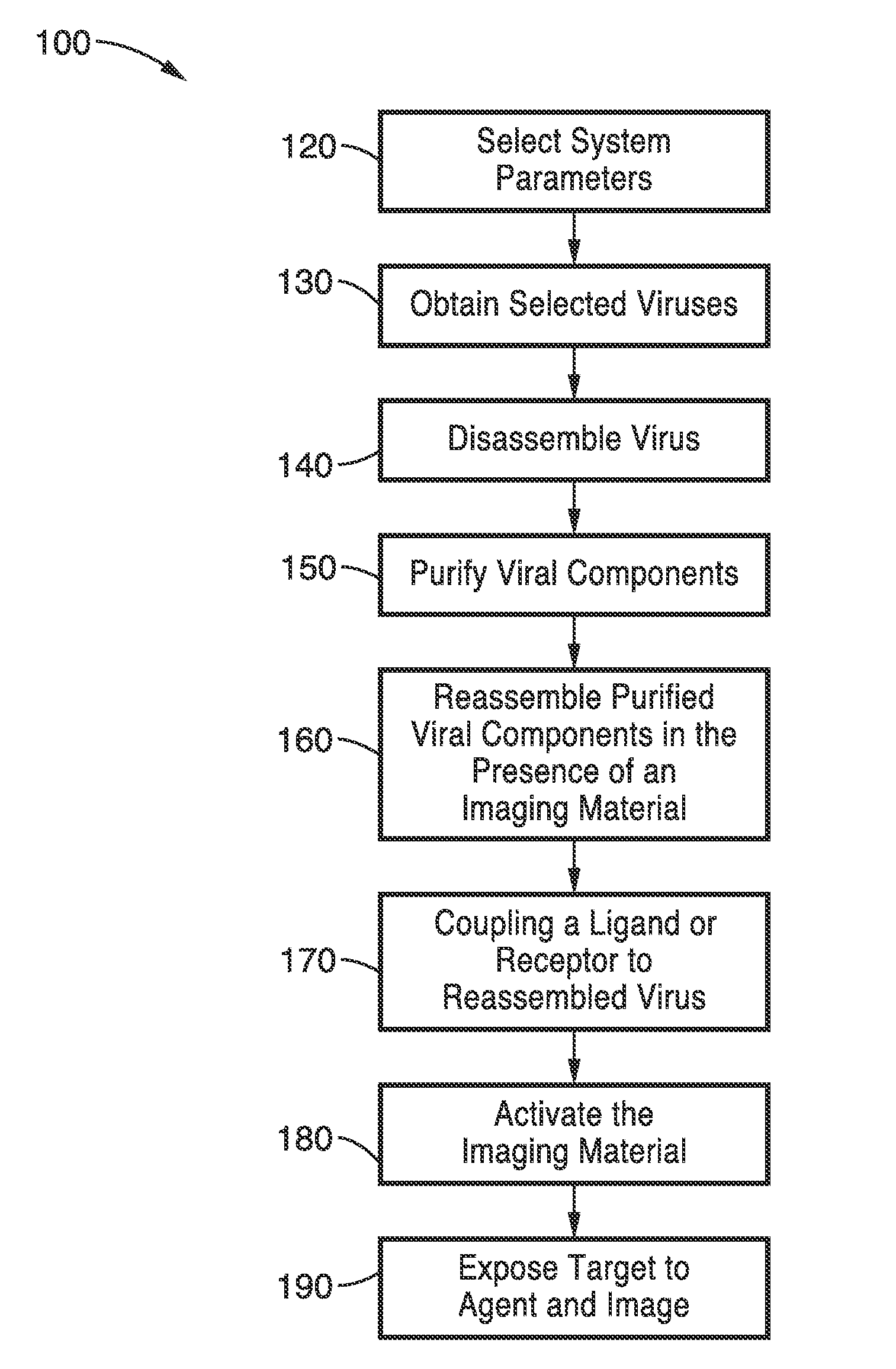Encapsulated agent guided imaging and therapies
a technology of encapsulated agents and imaging, applied in the direction of powder delivery, chemical/physical/physicochemical processes, viruses, etc., can solve the problems of short vascular circulation time, limited true potential of non-toxic and clinically proven optical probes, and difficulty in optical imaging and phototherapy of various diseases, etc., to achieve the effect of improving the circulation tim
- Summary
- Abstract
- Description
- Claims
- Application Information
AI Technical Summary
Benefits of technology
Problems solved by technology
Method used
Image
Examples
example 1
[0062]In order to demonstrate the functionality of the encapsulation methods, a new type of an optical nano-probe, based on genome-depleted plant Brome Mosaic Virus (BMV) whose interior is doped with indocyanine green (ICG), an FDA-approved near infrared (NIR) fluorescent dye was engineered. The nano-probes, derived from naturally occurring building blocks, are referred to as optical viral ghosts (OVG's) since the viral particles no longer contain the genomic machinery for replication. Only the capsid protein (outer shell) of the native virus remains intact, and provides the encapsulating structure for ICG.
[0063]BMV is a member of the family Bromoviridae of plant RNA viruses. It is a non-enveloped icosahedral virus whose shell is composed of 180 subunits of a 20 kDa capsid protein (cp). The genome of BMV is divided among four RNAs. Viral replication is dependent on interaction between non-structural replicase proteins, encoded by genomic RNA1 and RNA2. The capsid protein gene is enc...
example 2
[0079]To demonstrate the viability of optical viral ghosts (OVG's) in cellular imaging, normal human bronchial epithelial cells (LHS-9) as model cells were used since certain types of lung cancers are derived from the bronchial epithelium. The cells were cultured for 24 hours in serum free culture medium supplied by the commercial vendor. OVG's were then delivered into cell culture medium and incubated for two hours. An optical filter that allowed transmission of NIR light greater than 780 nm was used to capture the fluorescent signal onto a CCD camera. Tungsten light filtered between 730 nm and 775 nm was used as the excitation source.
[0080]False-color confocal fluorescent images of the human bronchial epithelial cells at 2 hr post-incubation with OVG's or free ICG (control) were obtained from a plane across the cells. The concentration of free ICG and that used in the construction of OVG's was 10 μg / ml. While free ICG remains mostly localized to the “rim” of the cells, OVG's are a...
example 3
[0083]To demonstrate the utility of the encapsulation methods with imaging compounds other than ICG, the methods were used with Alexa 488-Dextran complex. The encapsulation process used the following steps: (1) disassociation / disassembly of the virus capsid; and (2) re-association / reassembly of the virus capsid in the presence of the encapsulation agent were used with Alexa Fluor 488 in this example.
[0084]To dissociate the virus capsid, the pH of the buffer solution containing the viral particles was raised to about pH 7.5 with 0.5 CaCl2 and 50 mM Tris-HCl. Additional reagents included 1 mM DTT to stabilize the solution, and 1 mM EDTA and 0.5 mM PMSF as protease inhibitors. A period of 24 hours for the disassociation process was allowed to eliminate the nucleotides of the virus (RNA in the case of BMV) and only preserve the capsid for the final reassociation / reassembly. Other reagents that increase the pH or alter the ionic strengths of the solution to levels that cause disassociati...
PUM
| Property | Measurement | Unit |
|---|---|---|
| Therapeutic | aaaaa | aaaaa |
| Energy | aaaaa | aaaaa |
| Biostability | aaaaa | aaaaa |
Abstract
Description
Claims
Application Information
 Login to View More
Login to View More - R&D
- Intellectual Property
- Life Sciences
- Materials
- Tech Scout
- Unparalleled Data Quality
- Higher Quality Content
- 60% Fewer Hallucinations
Browse by: Latest US Patents, China's latest patents, Technical Efficacy Thesaurus, Application Domain, Technology Topic, Popular Technical Reports.
© 2025 PatSnap. All rights reserved.Legal|Privacy policy|Modern Slavery Act Transparency Statement|Sitemap|About US| Contact US: help@patsnap.com



